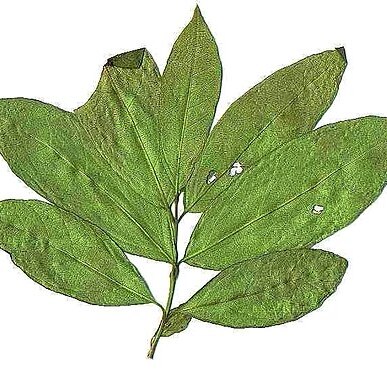Tall branched, evergreen tree with rounded crown, 10–35 m. high (rarely shorter), with neither spines nor tendrils; bark smooth, grey; branchlets pale grey or buff, lenticellate, ascending, glabrous or more rarely pubescent.. Leaves shortly petiolate or subsessile, subcoriaceous, broadly to narrowly elliptic, more rarely ovate to ovate-lanceolate, 4–11 cm. long, 1.7–5 cm. wide, generally acuminate, more rarely acute or obtuse, cuneate at the base, glabrous above, glabrous or with angle hairs or pubescent beneath, 3-nerved from about 1 cm. above base, with a fainter submarginal nerve from the base; tertiary nerves spreading, not very prominent.. Cymes axillary and terminal, compound, dichasial, fairly dense, 1–2.5 cm. long, pubescent with short spreading hairs; peduncle usually short, rarely up to 4 cm. long.. Flowers 4–5-merous, subsessile, about 3 mm. long.. Calyx-lobes broadly ovate to suborbicular, about 1.7 mm. long, pubescent on the back, ciliate.. Corolla cream, yellow or greenish; tube shortly campanulate, glabrous; lobes ovate-deltoid, subequal to the tube or slightly longer with dense hairs at the base.. Stamens inserted about the middle of the corolla-tube on short filaments; anthers just exserted.. Ovary ovoid, slightly longer than the style.. Fruit subglobose, 1.2–2 cm. long, with a thin yellow to orange rind; calyx and bracteoles persistent.. Seeds 1(–2), subellipsoid, usually flattened on one side, 1–1.2 cm. long; dried-up mesocarp often adhering to seed-coat as a rugose or foveolate covering; hilum often conspicuous in centre of ellipsoid surface.
Tree or shrub, 4-35 m high, bark grey-brown. Leaves decussate, glabrous, shiny both sides, elliptic, oblong or narrowly ovate, apex acuminate, margins revolute; petioles short. Inflorescence terminal or axillary, dense; peduncle pubescent, short. Flowers 5-merous, cream-coloured. Calyx green, connate at base, apex obtuse, 4-lobed, ovate. Corolla 4-lobed, creamy white, villose inner surface, glabrous outer surface; tube short, campanulate. Stamens 4, exserted on corolla tube; anthers oblong; filaments glabrous, short. Ovary with up to 15 ovules; style straight, stigma capitate, small. Flowering time Dec.-Mar. Fruit 1-seeded, subglobose, yellow-orange, small. Seeds subellipsoid, testa thin, hilum at central flattened side.
Leaves with a 2–5 mm. long, glabrous or sometimes (if branchlets hairy) pubescent petiole; lamina shining and dark green above, paler beneath, coriaceous (not thick), narrowly elliptic, oblong, or sometimes ovate or narrowly ovate, 1·7–3·5 times as long as wide, 4–11·5 x 1·5–5 cm., usually comparatively narrower towards the apices of the branchlets, mostly acuminate, more rarely acute or obtuse at the apex, cuneate or rounded at the base or decurrent into the petiole, glabrous or sometimes pubescent on both sides, with one pair of distinct secondary veins from about 1 cm. above the base and a faint submarginal pair from the base; tertiary venation spreading, not very prominent.
Corolla in the mature bud 2–2·7 times as long as the calyx, 3·5–4 mm. long, and rounded at the apex, creamy, yellow, or greenish, outside glabrous, inside densely villose at the base of the lobes; tube campanulate, 0·9–1·3(1·5) x as long as the calyx, 0·6–1·2 times as long as the lobes, 1·5–2·2 mm. long; lobes thick at the apex, triangular to ovate, 1·1–1·7 times as long as wide, 1·5–2·5 x 1·1–1·8 mm., acute at the apex, often slightly widened above the base, spreading or sometimes recurved.
Tree, 10-14 m high. Branchlets often pubescent, with a pair of persistent pointed cataphylls near base. Leaves up to 100 mm long, sometimes with acarodomatia. Inflorescence pubescent, lateral. Calyx petaloid, lobes broad. Fruit small, 13 mm in diameter. Flowers creamy yellow.
Sepals pale green, connate at the very base, broadly ovate or orbicular, about as long as wide, 1·5–1·8 x 1·5–1·8 mm., obtusely acute at the apex, ciliate, pubescent to glabrous outside, glabrous and with colleters at the base inside.
Stamens just exserted; filaments glabrous, short, inserted at two–thirds from the base of the corolla tube; anthers cordate–circular when young, becoming oblong after the pollen is shed, 1–1·2 x 0·6–0·7 mm., bearded at the base.
Seeds 1(–2), pale ochraceous, subellipsoid, usually flattened at one side, 1–1·2 x 0·8–1 x 0·5–0·6 cm., smooth, glabrous, not grooved, very minutely foveolate; hilum in the middle of the mostly flattened side.
Branches pale grey or buff, mostly paler than in S. mellodora, lenticellate, ascending, with a fissured bark; branchlets glabrous or sometimes pubescent, sulcate when dry.
Pistil glabrous, 2·3–3 mm. long; ovary ovoid or ovoid–conical, about 1–5 times as long as wide, 1·2 x 0·7–1·3 mm., 2–celled; style 0·8–1·5 mm. long; stigma capitate.
Inflorescence axillary and terminal, usually dense, much shorter than the leaves, 1–3(4) x 1–2·5 cm.
Trunk 20–100 cm. in diam.; bark smooth, grey, grey–green, or grey–brown; wood whitish, hard.
Fruit yellow or orange, small, subglobose, 1–2 cm. in diam. Wall thin.
Flowers 4–5–merous even in a single inflorescence, sessile.
Evergreen tree with a rounded crown, 6–35(40) m. high.
A tall tree without spines or tendrils
Peduncle pubescent, usually short.
In each cell about 10–15 ovules.
Flowers in short axillary cymes
Fruits yellow or orange.
Branchlets pubescent
Testa thin.
A tree.

